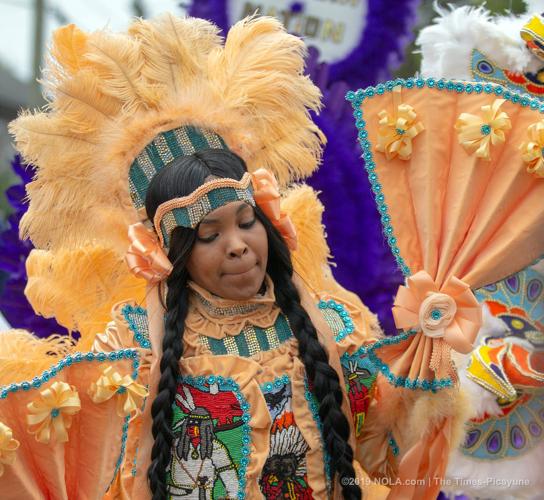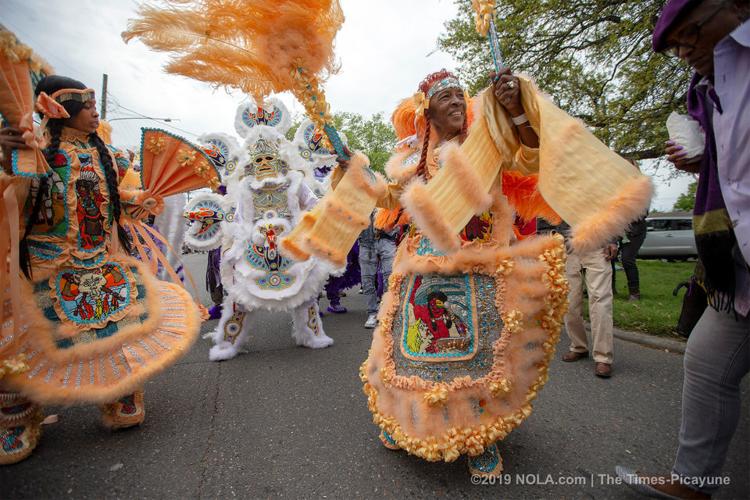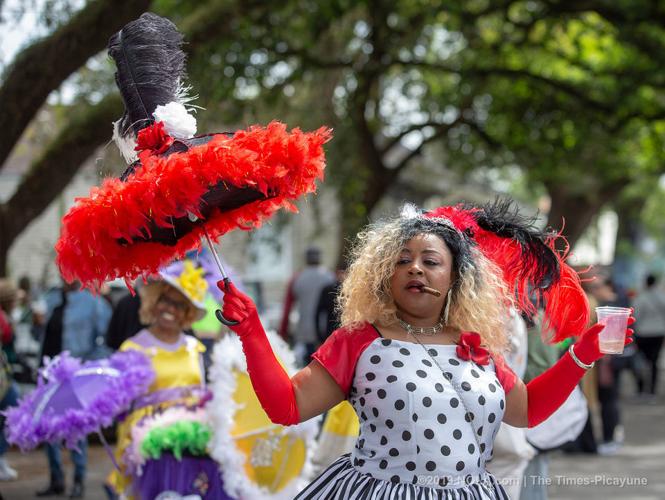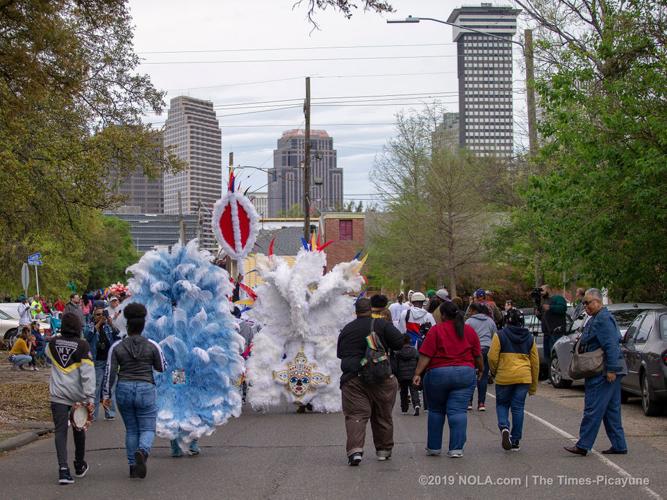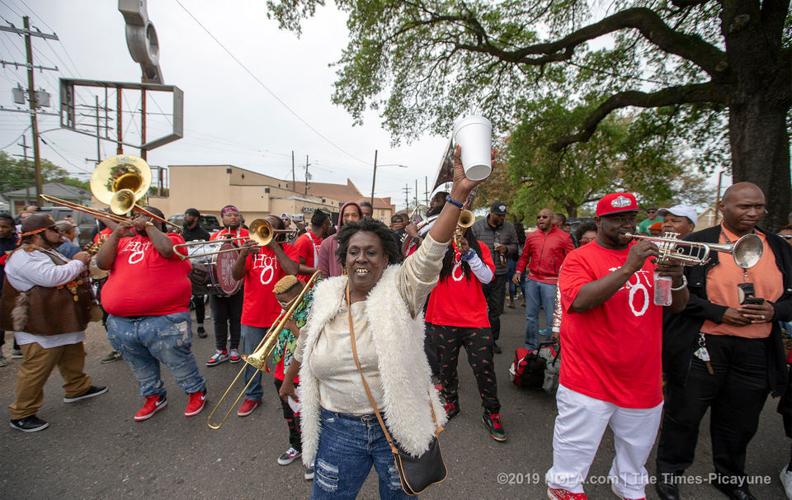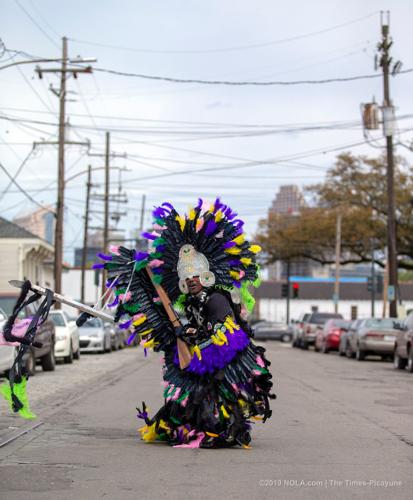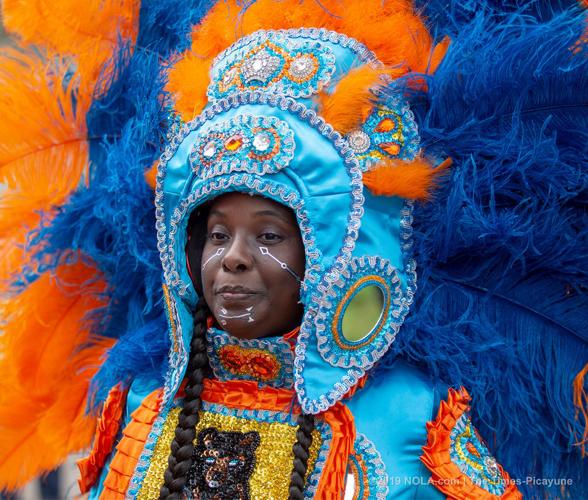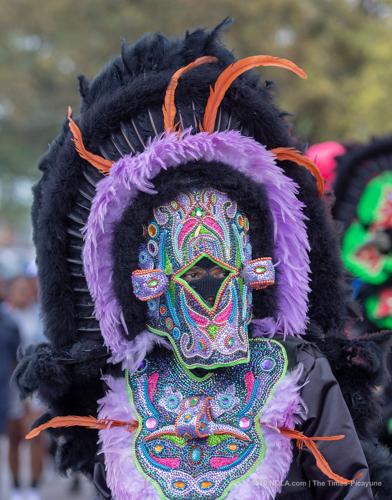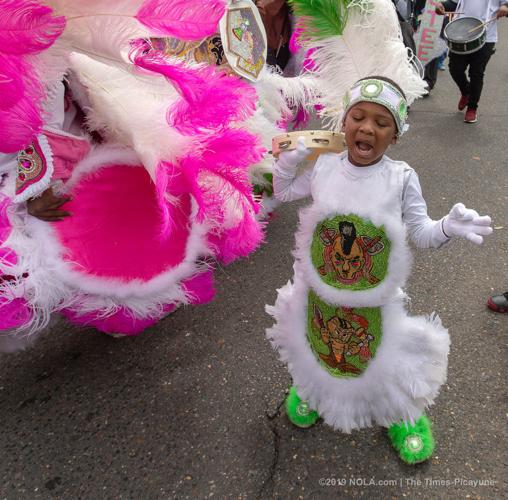If it weren’t for the coronavirus, Mardi Gras Indian fans would be getting ready for the annual Super Sunday Mardi Gras Indian marches that usually take place over the next few weeks. To stand on the curb watching fantastically colorful, feather-coated figures pass by, to the sound of rattling tambourines and age-old chants, is one of the most singular and spectacular New Orleans experiences.
There’s no question about that. The question is, should we be calling them Mardi Gras Indians? Other terms, such as Black Masking Indians and Black Indians are in use as well.
The elaborately beaded, feathered suits worn by New Orleans maskers may have been inspired by traditional Native American dress, but they are an expression of African heritage, too. Deciding on the most appropriate label to apply to the custom is complicated. The answer depends on whom you talk to.

Jerome Carter, the grandson of "Gator June" Johnson, helps Gerard "Bo Jr." Dollis put on his Mardi Gras Indian headdress at the Jazz and Heritage Festival during a memorial performance for his late father Big Chief Bo Dollis of the Wild Magnolias in 2016
Big Chief Bo Dollis Jr.
“It’s up to your preference,” said Bo Dollis Jr., of the Wild Magnolias tribe. “All the time that I was coming up, it was always Mardi Gras Indians,” he said.
After Katrina, when many Mardi Gras Indians had been displaced by the flood, Dollis began hearing other terms, like Black Masking Indians, he said. Those labels may have become more prevalent during the Black Lives Matter era, to emphasize that Mardi Gras Indian masking is an expression of Black culture, he said.
Dollis, who is 40, said that the difference in terminology may be generational, with younger people adopting the less well-known terms. But, he said, “I was brought up on Mardi Gras Indians. I’m more old-school and that’s the way I keep it.”
New Orleans’ Mardi Gras Indians have been stymied by the coronavirus, just like everyone else.

New Orleans-born historic interpreter and Black Indian masker Dianne Honore, with her all-white suit for Mardi Gras 2021
Queen Dianne Honore
Dianne Honore of the Yellow Pocahontas tribe is new to Indian masking. She sewed her first suit last year and debuted it in a small, socially distanced, outdoor gathering on Mardi Gras morning 2021.
Honore said she prefers the term “Black Indian.” The phrase Mardi Gras Indians was applied to the tradition somewhere along the line, because most people only saw Black Indian maskers on Mardi Gras, she said. But the term hasn’t always been as prevalent.
When she was a child in the 1960s, “we said Indians,” Honore said. Back then, she said, the maskers were part of close-knit neighborhood communities. She believes the use of the phrase Mardi Gras Indians was part of the popularization of the practice that came later, as the Black Indians suits and songs became more broadly known.

Mohawk Hunters Spy Boy Dow Edwards rests on horses on a hot and humid day as fellow Mardi Gras Indians, friends, and family say goodbye to Golden Star Hunters Mardi Gras Indians Big Chief Larry Bannock at his funeral outside of the City of Love Church in New Orleans, La. Saturday, May 10, 2014. Bannock passed away 3 days after a performance at Jazz Fest.
Big Chief Dow Edwards
Dow Edwards, of the Timbuktu Warriors tribe, said he uses “interlocking, interchangeable” terms, from Black Masking Mardi Gras Indians to, simply, Mardi Gras Indians.
“There are many currents flowing with the titles, and I don’t think there can be any one definition of the culture,” he said. “It’s like a gumbo, with new things added to it, as people try to define themselves in the moment.”
“It’s hard for an outsider to get it right, because we, inside the culture, use different terms,” he said. “Each tribe has its own individual way of doing it.”
Edwards, 59, thinks that early on, newspapers described maskers as Indians, then later the phrase Mardi Gras Indians took hold. The label was convenient, but it didn’t fit perfectly with the phenomenon, because it didn’t acknowledge the Black aspect of the custom.
Edwards said that he’s heard alternate terms to Mardi Gras Indian being employed more over the past 12 years or so. But the various titles all go back decades. Edwards pointed out that a film titled “Black Indians of New Orleans,” which is considered the first documentary of the phenomenon, was released way back in 1976.

Demond Melancon, of the Young Seminole Hunters, staged a political statement on Mardi Gras morning 2021 when he displayed his African-centric suit on the former site of a statue to Confederate president Jefferson Davis.
Big Chief Demond Melancon
Demond Melancon, of the Young Seminole Hunters, said that the term he’d like to see adopted by the public and the press is Black Maskers.
Melancon, 42, said that in 1992, when he began masking, “You were an Indian.” But now, he said, “the culture needs to evolve into what it really is. It’s been a hidden culture for 250 years and you have to know where it really comes from.”
A lot of maskers in New Orleans use their suits to “pay homage” to the Native Americans who provided refuge to freedom-seeking Blacks during the era of slavery. But the masking culture actually comes from Africa via those enslaved people, he said.
“The narrative needs to change,” he said. “We need African stories in the schools and we need African stories in the streets.”
Melancon pointed out that the label Mardi Gras Indians may be instantly understood in New Orleans, but outside of the city and to out-of-towners it can be unclear. “We get profiled as Indians,” he said. “People ask us, ‘What are you, Cherokee?’”
Melancon said he’d like to avoid that sort of misunderstanding.
Canal Street commuters’ heads swiveled on Mardi Gras morning at the sight of a magnificent Mardi Gras Indian suit standing on the spot once oc…

Darryl Montana, center, the son of the late Big Chief Allison 'Tootie' Montana, joins others as they play their tambourines in Congo Square for the start of Twelfth Night in New Orleans on Jan. 6. The blessing of the tambourines was part of this year's Big Chief Tootie Montana Day, as proclaimed by the city of New Orleans.
Big Chief Darryl Montana
Darryl Montana of the Yellow Pocahontas tribe, said that use of the term Mardi Gras Indians probably “has something to do with the community you came from.”
“We never called ourselves Mardi Gras Indians,” said Montana, 65, who has masked in the 7th Ward neighborhood for more than 50 years. They were just called “the Indians.”
The label Mardi Gras Indian wouldn’t have made much sense in his community, he said, because the pre-Lenten holiday was called Carnival. The term Mardi Gras was reserved to playfully describe anyone wearing a costume. “People would say, ‘I see you, Mardi Gras,’” he said. But the prefix wasn’t applied to Indians.
The description Mardi Gras Indian is too narrow, in Montana’s view. Since Black maskers take to the streets on St. Joseph’s night, as well as Mardi Gras morning, “why aren’t they called St. Joseph Night Indians?” he asked rhetorically.
Montana acknowledges that the term Mardi Gras Indian is convenient and has become broadly understood. “The horse is already out of the stable,” he said. But he views it as a sort of inauthentic brand name and prefers the term Black Masking Indians.
Tambourines rattled and popped around the life-size, bronze statue of the late Big Chief Allison “Tootie” Montana in Armstrong Park on Wednesd…

A suit worn by Kim Vaz-Deville, on display at the 'Mystery in Motion' exhibition which celebrates the carnival traditions of the Black community in New Orleans.
Professor Kim Vaz-Deville
Kim Vaz-Deville is professor of education and former associate dean of the College of Arts and Sciences at Xavier University of Louisiana. She is also the co-curator of the “Mystery in Motion: African American Masking and Spirituality in Mardi Gras” at the Louisiana State Museum on Jackson Square. Plus, she is a Black Masking Indian with the Golden Feather Hunters tribe.
“I guess people have to call them something,” Vaz-Deville said of the widespread use of the term Mardi Gras Indians. “I know it was for identification, but it’s a term that came about from transculturation, when different marginalized cultures met and new practices formed.”
The terminology was different in the 1970s, she said. “I grew up here, and I remember when they were just Black Indians.”
The term Mardi Gras Indians is problematic. “We’re dealing with layers of misnaming,” she said. For example, Vaz-Deville pointed out that Native Americans weren’t really from India in the first place, so the term Indians is commonplace but incorrect.
Such misnomers are “a continuation of the afterlife of colonialism and imperialism,” she said.
Vaz-Deville said she prefers the term Black Masking Indian, because “it’s where contemporary practice usage is moving.”
The shouting and the rattling of tambourines may be absent in 2021, but the spirit of New Orleans' Mardi Gras Indians persists. Spirit is the …

Big Chief Tyrone Casby, Sr. of the Mohawk Hunters Mardi Gras Indians parades past the Congo Square Stage during Jazz Fest 2013
Big Chief Tyrone Casby Sr.
Tyrone Casby Sr., of the Mohawk Hunters, serves as secretary of the New Orleans Mardi Gras Indian Council, which represents 15 of the roughly 60 tribes. Casby, 67, said that he and the council prefer the term Mardi Gras Indians.
“That’s who we were in the 1930s,” he said.
Casby said he doesn’t intend his opinion as “a knock on anyone else,” but he finds some of the other terms confusing, such as Black Masking Indians. “I’m already Black,” he said, “it’s understood.”
Casby suggests that fans of the Mardi Gras Indians take an ecumenical approach to describing the custom. When possible, he said, use the term that the individual masker chooses.
“Ask them what they’d like to be called and call them that,” he said.


















